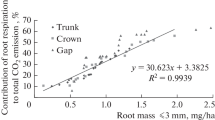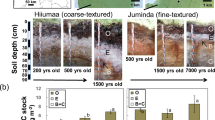Abstract
Patterns of lateral intrabiogeocenotic (between separate elementary biogeoranges) and interbiogeocenotic variability in the content of secondary metabolites and nutritional elements in the different-age needles of spruce (Picea abies ssp. obovata (Ledeb.) Domin) have been studied along the geochemical transect in spruce forests in northern taiga (Kola Peninsula). The perennial needles of spruce undergrowth (30–40 years) are characterized by a higher concentration of carbon, lignin, high-molecular-weight phenolic compounds, bounded tannins, and wide ranges of lignin/cellulose and lignin/N ratios compared to trees older than 100 years. The needles of spruce trees older than 100 years have significantly more bounded tannins and low-molecular-weight phenols in transitional and accumulative sites than in automorphic locations. The concentration of lignin and lignin/N ratio was significantly higher in the 5–7-year-old needles of spruce trees growing in automorphic conditions, while spruce forests in transitional and accumulative sites have the maximum values of these indicators for the current-year needles. Changes in the chemical composition of spruce needles along the geochemical transect are determined by (1) different concentrations of nutritional elements and secondary metabolites in soils; (2) increased soil moisture from automorphic to accumulative sites; (3) the features of the microbiological activity of soils; and (4) environmental factors (light, temperature, etc.).

Similar content being viewed by others
REFERENCES
Aitkenhead-Peterson, J.A., Alexander, J.E., Albrechtová, J., Krám, P., Rock, B., Cudlín, P., Hruška, J., Lhotaková, Z., Huntley, R., Oulehle, F., Polák, T., and McDo-well, W.H., Linking foliar chemistry to forest floor solid and solution phase organic C and N in Picea abies (L.) Karst stands in northern Bohemia, Plant Soil, 2006, vol. 283, nos. 1–2, pp. 187–201.
Artemkina, N.A., The content of phenolic compounds in V. vitis-idaea L. of pine forests of Kola Peninsula, Khim. Rastit. Syr’ya, 2010, no. 3, pp. 153–160.
Artemkina, N.A. and Gorbacheva, T.T., The adsorption of monomeric phenolic forms by soil from plant litter and litters in green moss-spruce forests, Lesovedenie, 2006, no. 3, pp. 50–56.
Artemkina, N.A. and Roshchin, V.I., Extractives of needles and shoots of Picea abies (L.) Karst. 1. Phenolic compounds: extraction and analysis, Rastit. Resur., 2004, vol. 40, no. 3, pp. 77–87.
Artemkina, N.A. and Roshchin, V.I., Extractives of needles and shoots of Picea abies (Pinaceae). 3. The dynamics of the content of phenolic compounds, Rastit. Resur., 2006, vol. 42, no. 3, pp. 66–73.
Artemkina, N.A., Orlova, M.A., and Lukina, N.V., Chemical composition of Juniperus sibirica needles (Cupressaceae) in the forest–tundra ecotone, the Khibiny Mountains, Russ. J. Ecol., 2016, vol. 47, no. 4, pp. 321–328.
Artemkina, N.A., Lukina, N.V., and Orlova, M.A., Spatial dynamics of the content of secondary metabolites, carbon, and nitrogen in the litter of northern taiga spruce forests, Lesovedenie, 2018, no. 1, pp. 37–47.
Barbehenn, R.V. and Constabel, C.P., Tannins in plant–herbivore interactions, Phytochemistry, 2011, vol. 72, no. 13, pp. 1551–1565.
Barton, K.E. and Koricheva, J., The ontogeny of plant defense and herbivory: characterizing general patterns using meta-analysis, Am. Nat., 2010, vol. 175, no. 4, pp. 481–493.
Berg, B., Foliar litter decomposition: a conceptual model with focus on pine (Pinus) litter—A genus with global distribution, ISRN Forestry, 2014, vol. 2014, art. ID 838169.
Blanco, J.A. The representation of allelopathy in ecosystem-level forest models, Ecol. Model., 2007, vol. 209, nos. 2–4, pp. 65–77.
Boege, K. and Marquis, R.J., Erratum: Facing herbivory as you grow up: the ontogeny of resistance in plants, Trends Ecol. Evol., 2005, vol. 20, no. 10, pp. 441–448.
Bryant, J.P., Chapin, F.S., III, and Klein, D.R., Carbon : nutrient balance of boreal plants in relation to vertebrate herbivory, Oikos, 1983, vol. 40, no. 3, pp. 357–368.
Close D.C. and Mcarthur C., Rethinking the role of many plant phenolics—protection from photodamage not herbivores? Oikos, 2002, vol. 99, no. 1, pp. 166–172.
Cheynier, V., Comte, G., Davies, K.M., Lattanzio, V., and Martens, S., Plant phenolics: recent advances on their biosynthesis, genetics, and ecophysiology, Plant Physiol. Biochem., 2013, vol. 72, pp. 1–20.
Croft, H., Chen, J.M., and Noland, T.L., Stand age effects on boreal forest physiology using a long time-series of satellite data, For. Ecol. Manage., 2014, vol. 328, pp. 202–208.
Fritz, C., Palacios-Rojas, N., Feil, R., and Stitt, M., Regulation of secondary metabolism by the carbon–nitrogen status in tobacco: nitrate inhibits large sectors of phenylpropanoid metabolism, Plant J., 2006, vol. 46, no. 4, pp. 533–548.
Giertych, M.J., Karolewski, P., and de Temmerman, L.O., Foliage age and pollution alter content of phenolic compounds and chemical elements in Pinus nigra needles, Water, Air, Soil Pollut., 1999, vol. 110, nos. 3–4, pp. 363–377.
Hamilton, J.G., Zangerl, A.R., DeLucia, E.H., and Berenbaum, M.R., The carbon-nutrient balance hypothesis: its rise and fall, Ecol. Lett., 2001, vol. 4, no. 1, pp. 86–95.
Hatcher, P.E., Seasonal and age-related variation in the needle quality of five conifer species, Oecologia, 1990, vol. 85, no. 2, pp. 200–212.
Hättenschwiler S. and Vitousek P.M., The role of polyphenols in terrestrial ecosystem nutrient cycling, Trends Ecol. Evol., 2000, vol. 15, no. 6, pp. 238–243.
Helmisaari, H.-S., Spatial and age-related variation in nutrient concentrations of Pinus sylvestris needles, Silva Fenn., 1992, vol. 26, no. 3, pp. 145–153.
Herms D.A. and Mattson W.J., The dilemma of plants: to grow or defend, Q. Rev. Biol., 1992, vol. 67, no. 3, pp. 283–335.
Horner, J.D., Cates, R.G., and Gosz, J.R., Tannin, nitrogen, and cell wall composition of green vs. senescent Douglas-fir foliage, Oecologia, 1987, vol. 72, no. 4, pp. 515–519.
Kabata-Pendias, A. and Pendias, H., Trace Elements in Soils and Plants, Boca Raton, Fl: CRC Press, 2001.
Kanerva, S., Kitunen, V., Loponen, J., and Smolander, A., Phenolic compounds and terpenes in soil organic horizon layers under silver birch, Norway spruce and Scots pine, Biol. Fertil. Soils, 2008, vol. 44, no. 4, pp. 547–556.
Kashulin, P.A., Kalacheva, N.V., Artemkina, N.A., and Chernous, S.A., Photochemical processes in the Northern plants and environment, Vestn. Murmansk. Gos. Tekh. Univ., 2009, vol. 12, no. 1, pp. 137–142.
Kazimirov, N.I. and Morozova, Biologicheskii krugovorot veshchestv v el’nikakh Karelii (Biological Cycle of Substances in Spruce Forests of Karelia), Leningrad: Nauka, 1973.
Kivimäenpää, M., Riikonen, J., Sutinen, S., and Holopainen, T., Cell structural changes in the mesophyll of Norway spruce needles by elevated ozone and elevated temperature in open-field exposure during cold acclimation, Tree Physiol., 2014, vol. 34, no. 4, pp. 389–403.
Koricheva, J., The Carbon-Nutrient Balance Hypothesis is dead; long live the carbon-nutrient balance hypothesis? Oikos, 2002, vol. 98, no. 3, pp. 537–539.
Kraus, T.E.C., Dahlgren, R.A., and Zasoski, R.J., Tannins in nutrient dynamics of forest ecosystems—a review, Plant Soil, 2003, vol. 256, no. 1, pp. 41–66.
Lukina, N.V. and Nikonov, V.V., Biogeokhimicheskie tsikly v lesakh Severa v usloviyakh aerotekhnogennogo zagryazneniya (Biogeochemical Cycles in Northern Soils Under Air Technogenic Pollution), Apatity: Kol’sk. Nauch. Tsentr, Ross. Akad. Nauk, 1996, part 1.
Lukina, N.V., Orlova, M.A., Steinnes, E., Artemkina, N.A., Gorbacheva, T.T., Smirnov, V.E., and Belova, E.A., Mass-loss rates from decomposition of plant residues in spruce forests near the northern tree line subject to strong air pollution, Environ. Sci. Pollut. Res., 2017, vol. 24, no. 24, pp. 19874–19887.
Luzikov, A.V., Trofimov, S.Ya., and Zagoskina, N.V., Relationship between pool of ammonium ions in soils and the content of phenolic compounds in spruce needles by example of virgin landscapes of Central Forest Nature Reserve, Vestn. Mosk. Univ., Ser. 17: Pochvoved., 2005, no. 3, pp. 42–47.
Makkonen, M., Berg, M.P., Handa, I.T., Hättenschwiler, S., van Ruijven, J., van Bodegom, P.M., and Aerts, R., Highly consistent effects of plant litter identity and functional traits on decomposition across a latitudinal gradient, Ecol. Lett., 2012, vol. 15, no. 9, pp. 1033–1041.
Manakov, K.N. and Nikonov, V.V., Biologicheskii krugovorot mineral’nykh elementov i pochvoobrazovanie v el’nikakh Krainego Severa (Biological Cycle of Mineral Elements and Pedogenesis in Spruce Forests of Extreme North), Leningrad: Nauka, 1981.
Mandre, M., Relationships between lignin and nutrients in Picea abies L. under alkaline air pollution, Water, Air Soil Pollut., 2002, vol. 133, nos. 1–4, pp. 361–377.
Marakaev, O.A., Celebrowsky, M.V., Nikolaeva, T.N., and Zagoskina, N.V., Some aspects of underground organs of spotleaf orchis growth and phenolic compounds accumulation at the generative stage of ontogenesis, Biol. Bull. (Moscow), 2013, vol. 40, no. 3, pp. 281–288.
Matyssek, R., Koricheva, J., Schnyder, H., Ernst, D., Munch, J.C., Oßwald, W., and Pretzsch, H., The balance between resource sequestration and retention: a challenge in plant science, in Growth and Defense in Plants, Ecological Studies Series vol. 220, Matyssek, R., Schnyder, H., Oßwald, W., Ernst, D., Munch, C., and Pretzsch, H., Eds., Berlin: Springer, 2012, pp. 3–24.
Medvedev, S.S., Fiziologiya rastenii: uchebnik (The Plant Physiology: Manual), St. Petersburg: S.-Peterb. Gos. Univ., 2004.
Orlova, M.A., Elementary unit of forest biogeocenotic cover for the assessment of ecosystem functions of forests, Tr. Karel’sk. Nauch. Tsentra, Ser. Ekol. Issled., 2013, no. 6, pp. 126–132.
Orlova, M.A., Lukina, N.V., Smirnov, V.E., and Artemkina, N.A., The influence of spruce on acidity and nutrient content in soils of northern taiga dwarf shrub–green moss spruce forests, Eurasian Soil Sci., 2016, vol. 49, no. 11, pp. 1276–1287.
Ossipova, S., Ossipov, V., Haukioja, E., Loponen, J., and Pihlaja, K., Proanthocyanidins of mountain birch leaves: quantification and properties, Phytochem. Anal., 2001, vol. 12, no. 2, pp. 128–133.
Plaksina, I.V., Sudachkova, N.E., Romanova, L.I., and Milyutina, I.L., Seasonal dynamics of phenolic compounds in the bast and needles of Scots pine and Siberian cedar in plantations with different density, Khim. Rastit. Syr’ya, 2009, no. 1, pp. 103–108.
Preston, C.M., Nault, J.R., Trofymow, J.A., Smyth, C., and CIDET Working Group, Chemical changes during 6 years of decomposition of 11 litters in some Canadian forest sites. Part 1. Elemental composition, tannins, phenolics, and proximate fractions, Ecosystems, 2009, vol. 12, no. 7, pp. 1053–1077.
Rowland, A.P. and Roberts, J.D., Lignin and cellulose fractionation in decomposition studies using acid-detergent fibre methods, Commun. Soil Sci. Plant Anal., 1994, vol. 25, nos. 3–4, pp. 269–277.
Rummukainen, A., Julkunen-Tiitto, R., Ryyppö, A., Kaunisto, S., Kilpeläinen, J., and Lehto, T., Long-term effects of boron and copper on phenolics and monoterpenes in Scots pine (Pinus sylvestris L.) needles, Plant Soil, 2013, vol. 373, no. 1, pp. 485–499.
Stamp, N., Out of the quagmire of plant defense hypotheses, Q. Rev. Biol., 2003, vol. 78, no. 1, pp. 23–55.
Vasil’ev, S.N., Roshchin, V.I., and Artemkina, N.A., The composition of the water-soluble fraction of extractive substances of wood greens of Picea abies (L.) Karst, Rastit. Resur., 1999a, vol. 35, no. 2, pp. 53–59.
Vasil’ev, S.N., Roshchin, V.I., and Artemkina, N.A., Phenolic extractive substances from species of the genus Picea A. Dietr, Rastit. Resur., 1999b, vol. 35, no. 2, pp. 15–31.
Vasil’ev, S.N., Kushnikova, E.A., and Artemkina, N.A., The dynamics of the content of extractive substances in wood green of Picea abies (L.) Karst, Rastit. Resur., 2001, vol. 37, no. 1, pp. 49–60.
Wam, H.K., Stolter, C., and Nybakken, L., Compositional changes in foliage phenolics with plant age, a natural experiment in boreal forests, J. Chem. Ecol., 2017, vol. 43, no. 9, pp. 920–928.
Zaprometov, M.N., Fenol’nye soedineniya: rasprostranenie, metabolizm i funktsii v rasteniyakh (Phenolic Compounds: Distribution, Metabolism, and Functions in the Plants), Moscow: Nauka, 1993.
Zhang, D., Hui, D., Luo, Y., and Zhou, G., Rates of litter decomposition in terrestrial ecosystems: global patterns and controlling factors, J. Plant Ecol., 2008, vol. 1, no. 2, pp. 85–93.
Funding
This study was held within the framework of the program of the Presidium of the Russian Academy of Sciences (0110-2018-0005) and the projects of state assignment to the Kola Science Center, Russian Academy of Sciences (0226-2018-0111), and Center for Forest Ecology and Productivity, Russian Academy of Sciences (AAAA-A18-118052400130-7).
Author information
Authors and Affiliations
Corresponding author
Ethics declarations
Conflict of interests
The authors declare that they have no conflicts of interest
Statement on the welfare of animals
This article does not contain any studies involving animals performed by any of the authors.
Additional information
Translated by D. Zabolotny
Rights and permissions
About this article
Cite this article
Artemkina, N.A., Orlova, M.A. & Lukina, N.V. Spatial Variation in the Concentration of Phenolic Compounds and Nutritional Elements in the Needles of Spruce in Northern Taiga Forests. Contemp. Probl. Ecol. 12, 769–779 (2019). https://doi.org/10.1134/S1995425519070023
Received:
Revised:
Accepted:
Published:
Issue Date:
DOI: https://doi.org/10.1134/S1995425519070023




